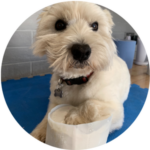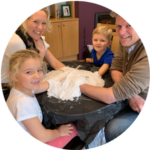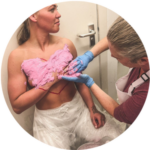As well as in-studio castings, home visits or alternative locations can be arranged for those who can not travel to the studio. Visits are also made to vet practices and Willow Tree Pet Cremations and the JSPCA to carry out pet bereavement castings.
Below provides a description of the different processes followed by FAQs which should answer some of your questions. Should you wish to discuss any process further or have other questions, please get in touch via the Contact Page or email info@lovecasting.je
Booking Terms – Please read before proceeding
3D Casting
Suitable for all ages, life casting is a process of creating a three-dimensional copy of a body part using a mould and casting techniques. The casting material is friendly to skin and is made nice and warm for our younger customers, so it sets really quickly. Depending on the keepsake you have chosen, on average an appointment will take 45 minutes.
 Baby Casting – Don’t worry, your baby does not need to remain still during the casting. It is helpful if they are content and settled so it is suggested that the baby is snoozy, breast/bottle fed just before or during the casting process. We’ll keep them distracted, standing, sitting, walking, whatever we need to do. The material takes around a minute to set per cast. Please don’t wear your Sunday best, sleep grows that can be easily removed to give access to hands and feet are best.
Baby Casting – Don’t worry, your baby does not need to remain still during the casting. It is helpful if they are content and settled so it is suggested that the baby is snoozy, breast/bottle fed just before or during the casting process. We’ll keep them distracted, standing, sitting, walking, whatever we need to do. The material takes around a minute to set per cast. Please don’t wear your Sunday best, sleep grows that can be easily removed to give access to hands and feet are best.
 Children – A bit more challenging dealing with toddlers and small children under the age of 5 or 6 as it can be harder for them to take instruction if they can at all. The material is like a warm custard setting into a rubbery jelly so it is quite a sensation and it’s just so hard not to wriggle and try to pull out of the mould. A toy box is on hand, but you may wish to bring a favourite toy, reward, digital device or a snack to keep them distracted or motivated.
Children – A bit more challenging dealing with toddlers and small children under the age of 5 or 6 as it can be harder for them to take instruction if they can at all. The material is like a warm custard setting into a rubbery jelly so it is quite a sensation and it’s just so hard not to wriggle and try to pull out of the mould. A toy box is on hand, but you may wish to bring a favourite toy, reward, digital device or a snack to keep them distracted or motivated.
 Family Hand Clasps – These are done bucket style and can accommodate up to 6 people at the most, depending on their age. The material takes a little longer to set 2-3 minutes. Still a quick and fun process for the everyone to enjoy. Individual family hands for framed keepsakes are also individual buckets and containers depending on the ages.
Family Hand Clasps – These are done bucket style and can accommodate up to 6 people at the most, depending on their age. The material takes a little longer to set 2-3 minutes. Still a quick and fun process for the everyone to enjoy. Individual family hands for framed keepsakes are also individual buckets and containers depending on the ages.
 Pet Casting – For framed keepsakes, the paw is held in the moulding material but not fully submerged for an easier release. For shelf based keepsakes, the paw needs to be fully submerged ‘bucket’ style. We’d have a chat before hand to ensure they are compatible. A mixture of coconut & sunflower oil and Vaseline is used to coat the fur to help prevent sticking. Please bring their favourite treats and a friend that is familiar to them so they can give the treats while we carry out the casting.
Pet Casting – For framed keepsakes, the paw is held in the moulding material but not fully submerged for an easier release. For shelf based keepsakes, the paw needs to be fully submerged ‘bucket’ style. We’d have a chat before hand to ensure they are compatible. A mixture of coconut & sunflower oil and Vaseline is used to coat the fur to help prevent sticking. Please bring their favourite treats and a friend that is familiar to them so they can give the treats while we carry out the casting.
 Linked Hands / Shell Casting – Offered for up to 5 people however, it can be reviewed if there are more hands requested. Linked hands are usually wall mounted but presentation will be discussed beforehand. The style of casting is ideal for adults and children over the age of 6 and includes a shell method. It takes about 30 minutes from start to finish, hence why it’s not suitable for younger children. A great experience, sitting around the table, chatting enjoying each other’s company.
Linked Hands / Shell Casting – Offered for up to 5 people however, it can be reviewed if there are more hands requested. Linked hands are usually wall mounted but presentation will be discussed beforehand. The style of casting is ideal for adults and children over the age of 6 and includes a shell method. It takes about 30 minutes from start to finish, hence why it’s not suitable for younger children. A great experience, sitting around the table, chatting enjoying each other’s company.
 Body Casting – Two types of body casting are available. 3D Body casts are created where the moulding material is applied, followed by a shell cast to ensure it holds it shape and structure when removed from the body. Modrock Casts are created using plaster bandages to capture your shape and curves. Both processes can take between on average 20 – 30 minutes depending on the body part. Comfort will be considered as one can be sitting, leaning, or standing for a period of time.
Body Casting – Two types of body casting are available. 3D Body casts are created where the moulding material is applied, followed by a shell cast to ensure it holds it shape and structure when removed from the body. Modrock Casts are created using plaster bandages to capture your shape and curves. Both processes can take between on average 20 – 30 minutes depending on the body part. Comfort will be considered as one can be sitting, leaning, or standing for a period of time.
 2D Impressions
2D Impressions
Appointments take approximately 15 – 20mins. Using terracotta clay; a hand, foot, or paw is pressed gently to create the impression. Plaster is then mixed and poured to create the shape and reversed impression. Please note that these tiles are light and therefore fragile. Care is required when handling.
 Prints for Silver Jewellery
Prints for Silver Jewellery
No ink, no mess, this process is done with an inkless wipe and magic paper. Smaller children really enjoy watching the magic happen. Fingerprints are taken using an ink kit.
